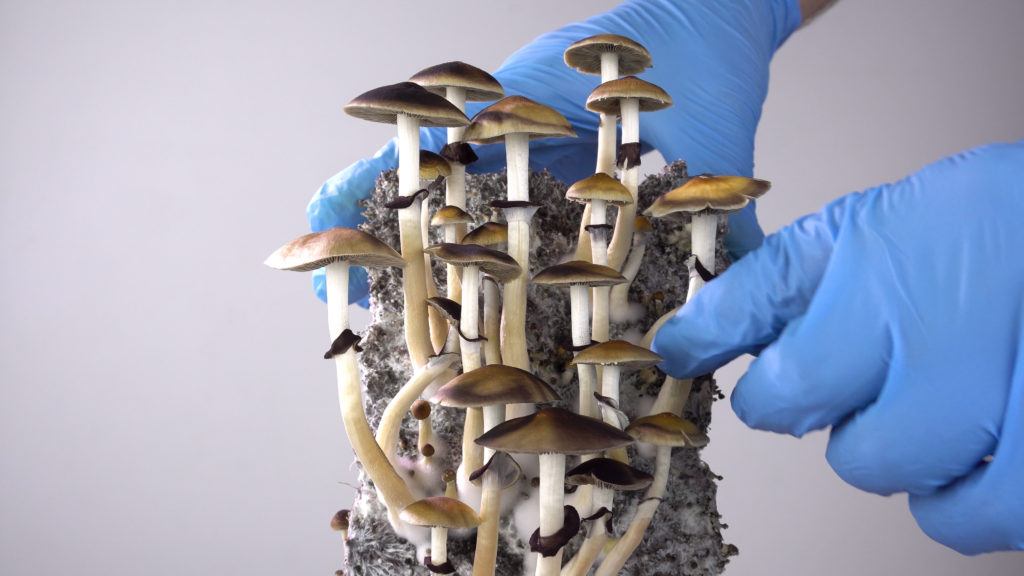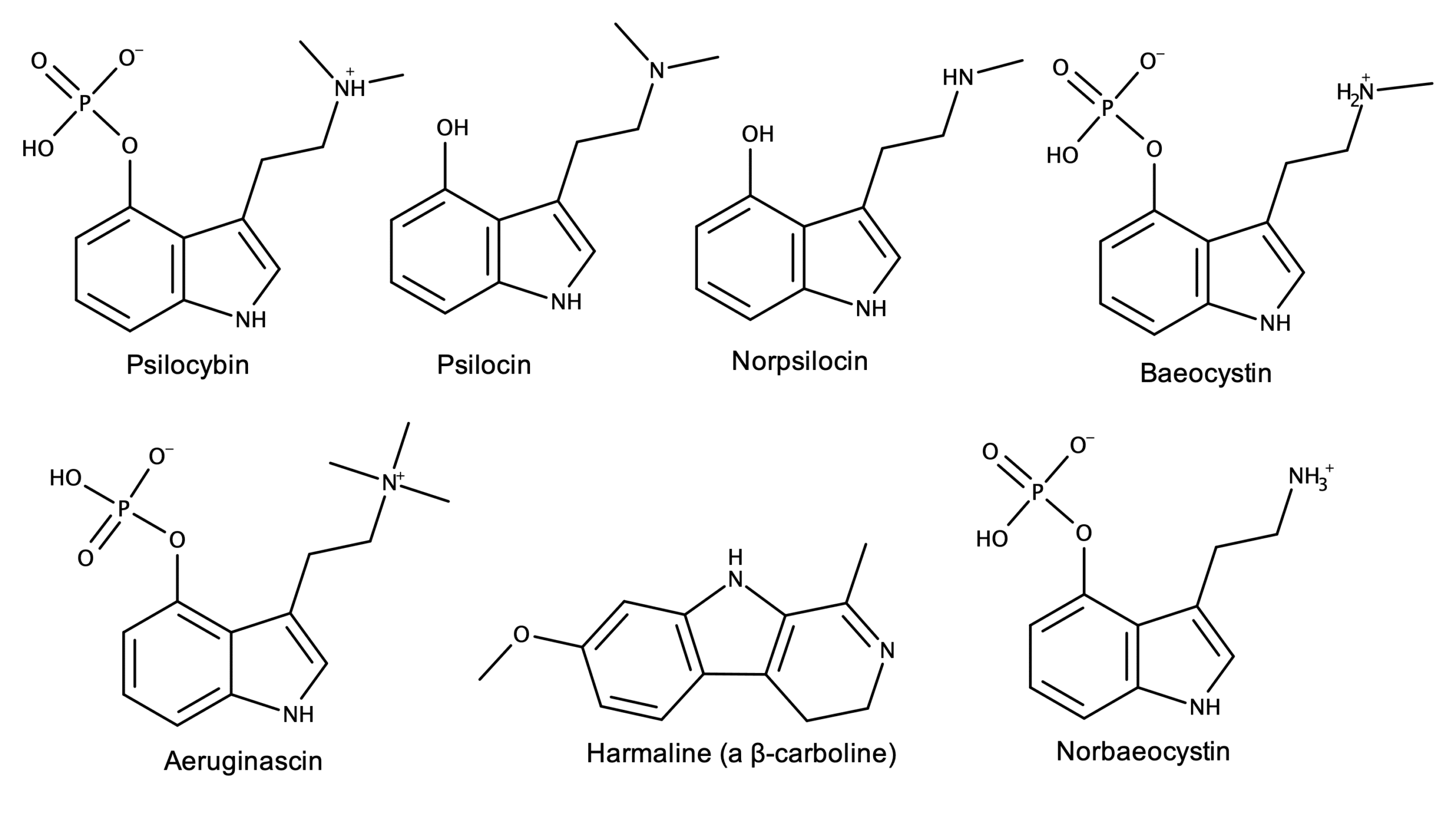
Psychedelic science consistently captures headlines because of the potential for treating conditions such as PTSD (post-traumatic stress disorder) and depression. Psilocybin, one of the most studied, is found in magic mushrooms and serves as a prodrug for psilocin.1 Aside from psilocybin/psilocin, these magic mushrooms also contain other biologically important compounds including norpsilocin,2 baeocystin,3 norbaeocystin,3 aeruginascin,4 and β-carbolines5 (Figure 1). Due to small but influential differences in chemical structure, these compounds present a unique avenue for exploration and potential therapeutic applications.
Studies examining the compounds in magic mushrooms, their quantities, and their effects on animals and humans have received more attention recently. Understanding the chemistry and pharmacology of these compounds (and those yet to be discovered) is essential for formulating medicines containing precise amounts of purified compounds targeting specific conditions.
Over the years, PSR has published numerous articles reviewing magic mushroom studies including the effects of magic mushroom compounds and new compound and enzyme discoveries. Similarly, the hypothesis of an entourage effect between magic mushroom compounds has been frequently discussed in articles such as “The Entourage Effect in Magic Mushrooms” and “More Evidence of the Chemical Compound Variability in Magic Mushrooms.”
As we head into 2024, here are some highlights from research emphasizing the need for purifying, identifying and characterizing the compounds in magic mushrooms as an essential first step for creating safe and effective magic mushroom formulations. Studies are increasingly aimed at understanding the nuanced differences in chemical composition and resultant biological effects of these two forms. This exploration is crucial in deciphering the diverse impacts on mental health and the potential applications in psychedelic therapy. The following research highlights key research efforts in this domain.
Mushroom Extract More Effective than Psilocybin for OCD
In 2009, a study investigated the differences between synthetic (“pure”) psilocybin and a methanol extract from the mycelia of Psilocybe argentipes on marble-burying behavior (an animal model for obsessive compulsive disorder, OCD6) in male mice.7
The authors described the analysis of the mushroom extract as follows: “Quantitative analysis by HPLC showed that mycelia from P. argentipes contained 0.024% psilocybin and 0.0008% psilocin. P. argentipes at a dose of 0.1–1 g/kg thus contained about 23.8–238 μg/kg psilocybin and 0.8–8 μg/kg, psilocin.”
The data indicated that the mushroom extract was more effective than psilocybin alone in reducing marble-burying behavior without affecting the locomotor activity of the mice. Specifically, 0.1-1.0 g/kg of mushroom extract significantly reduced the number of buried marbles while the psilocybin data showed significant reduction at 1.5 mg/kg. The authors summarized by saying,
“These findings suggest that inhibition of marble-burying behavior by P. argentipes is due to the involvement of a variety of psychoactive substances.”
Synthesis and Biological Evaluation of Mushroom Tryptamines
Alexander Sherwood of the Unsona Institute and his reasearch team published a study in 2020 that focused on the synthesis and biological evaluation of several tryptamines found in hallucinogenic mushrooms, namely norbaeocystin, baeocystin, norpsilocin, and aeruginascin.8 The study aimed to analyze their psychoactive properties and potential therapeutic uses, comparing them to known substances like psilocybin. Key findings included the identification of potent 5-HT2A receptor agonists and the observation that some compounds, such as norpsilocin, showed unique therapeutic potential without strong psychedelic effects. The research expanded knowledge on the pharmacological diversity of magic mushrooms and their use in psychedelic therapy.
Effects of Psilocybin vs. Mushroom Extracts
Shahar et al. 2023 compared the chemical profiles of synthesized psilocybin and psychedelic mushroom extracts to understand their differing biological effects.9 The study employed HPLC and MS for quantitative analysis, revealing significant variations in the chemical makeup of synthetic psilocybin and natural extracts, which included a range of compounds potentially contributing to the psychedelic experience. Although animal behavior remained unchanged, synaptic protein levels varied, which the authors believe could be an indication of neuroplastic effects of mushroom extracts not present in the synthesized psilocybin treatment alone. The study highlighted the complex interactions of compounds in natural sources and their potential therapeutic implications, different from synthetic psilocybin.
Antidepressant and Anxiolytic Effects of Mushroom Extracts
Hernandez-Leon and colleagues’ 2024 study investigated the antidepressant and anxiolytic effects of Psilocybe cubensis mushroom extracts.10 Focused on treating Major Depressive Disorder and anxiety, particularly post-SARS-CoV-2 pandemic, the study utilized chemical analyses and pharmacological evaluations on male mice. Results showed significant antidepressant and anxiolytic effects without sedation, suggesting P. cubensis as a potential alternative treatment for these mental health conditions. This study supports the use of these mushrooms in traditional medicine and calls for further research on their long-term use and interactions in mental health therapies.
Crystal Structures and SARs
The psychedelic research company CaaMTech has published papers (and been awarded patents) on dozens of tryptamine crystal structures they have solved. These compounds include 4-AcO-DMT (psilacetin) fumarate,11 the freebase and fumarate salt of 4-HO-NMT (norpsilocin),12 (baeocystin),13 serotonin,14 and the hydrochloride salts of nine serotonin analogs.15 Many of the compounds in CaaMTechs’ crystal structure catalog (such as serotonin, baeocystin, and norpsilocin) are found in magic mushrooms.
Characterizing this work as “fundamental science” for the psychedelics industry, CaaMTech moves many of its compounds into preclinical testing in cooperation with the The National Institute on Drug Abuse (NIDA) Designer Drug Research Unit (DDRU). This work takes the form of structure-activity relationship (SAR) studies that are seeking to understand how small changes in the chemical structure of a compound can translate into large changes in its biological activity.16-19 This type of structure elucidation and testing allows scientists to create new compounds with optimized properties.
A Word About Processing and Storing Mushrooms
Many studies examining the compounds in magic mushrooms describe the technique of drying and pulverizing the fruiting bodies prior to mixing with saline for dosing mice and/or performing an extraction in a suitable solvent. Researchers should be aware of what happens to the compounds as mushrooms undergo this processing. For example, using Psilocybe cubensis, a 2020 study found that “the unprocessed fresh mushrooms contained approximately 30% more tryptamines than the chopped fresh mushrooms.”20 In addition, the data revealed 0.25 wt.% of psilocin in fresh mushrooms while there was only 0.16 wt.% detected in the dried mushroom powder. The study also found “rapid degradation of all analytes” when dried mushroom powder was stored at room temperature, below freezing, or in lighted or dark conditions.
Where Should Magic Mushroom Research be Heading?
As the commitment of these researchers continues, it becomes imperative to reflect on the fundamental gaps in our knowledge of psychedelic mushroom research. Paramount among these is the necessity for a comprehensive cataloging of the myriad compounds contained within these mushrooms. Such an inventory lays the groundwork for unraveling the intricate chemistry and pharmacology of each one. This understanding is pivotal, particularly in discerning the entourage effect, which could hold significant clinical relevance in therapeutic contexts where formulations require meticulously calibrated concentrations of specific compounds. This is a problem which could be solved in the not too distant future.
